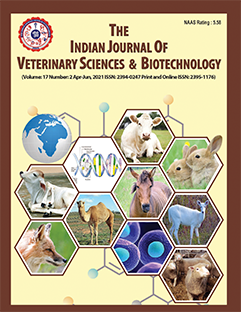Therapeutic Management of Haemotoxic Snake Envenomation in Dogs – A Field Study
DOI:
https://doi.org/10.48165/ijvsbt.21.5.38Keywords:
veterinarians, poisonous, prevalent, extremities, dogsAbstract
Snake envenomation is a life threatening, emergency and challenging case to be handled by veterinarians especially in the rural parts of India. Out of 3500 different species of snakes around the world, about 600 species were found to be poisonous (Sandhu and Brar, 2008). In India, about 216 species of snakes are present, out of which 60 species are reported to be poisonous (Gupta and Peshin, 2014). The snake envenomation in livestock and companion animals occurs commonly in summer months. It is more prevalent in rural areas of India which are filled with bushes and trees (Garg, 2002). Most snake bites occur usually on head and extremities in small animals and on legs in large animals (Sandhu and Brar, 2008). The clinical signs caused by the snake envenomation depend upon the type of toxins present in the venom. The neurotoxic venom causes paralysis of respiratory centre /respiratory muscles, whereas haemotoxic venom causes coagulopathies/bleeding disorders, haemolysis and cardiotoxicity (Sandhu and Brar, 2008). The current paper describes the haemotoxic snake envenomation in three dogs and its therapeutic management.
Downloads
References
Constable, P.D., Hinchcliff, K.W., Done, S.H., & Grünberg, W. (2016). Multi-organ diseases due to toxicity of snakebite. In: Veterinary Medicine: A Textbook of the Diseases of Cattle, Horses, Sheep, Pigs and Goats. Elsevier Health Sciences, pp. 2176-2179.
Garg, S.K. (2002). Zootoxins. In: Veterinary Toxicology, 1st edn., CBS Publishers and Distributors, New Delhi, India.
Gupta, Y.K., & Peshin, S.S. (2014). Snake bite in India: Current scenario of an old problem. Journal of Clinical Toxicology, 4, 182.
Kumar, A., Rohi, R.R., Pawar, P., Yadav, R., & Yadav, P. (2016). Therapeutic management of snakebite in a male dog. Scholars Journal of Agriculture and Veterinary Sciences, 3(2), 103-104.
Peterson, M. (2017). Venomous Bites and Stings (Zootoxicoses). In: Textbook of Veterinary Internal Medicine, 8th edn., Ettinger, S.J., Feldman, E.C., & Côté, E. (Eds.), Missouri, USA, pp. 1698-1710.
Sandhu, H.S., & Brar, R.S. (2008). Textbook of Veterinary Toxicology, 2nd edn., Kalyani Publishers, New Delhi, India.
WHO (2016). World Health Organization: Guidelines for the Management of Snakebites, 2nd edn., Regional Office for South-East Asia, pp. 1-208.
Downloads
Published
Issue
Section
License
Copyright (c) 2025 Indian Journal of Veterinary Sciences and Biotechnology

This work is licensed under a Creative Commons Attribution-NonCommercial-NoDerivatives 4.0 International License.




